
All Solutions
Section 1-7: Investigating Horizontal Stretches, Compressions, and Reflections
If $f(x)$ contains the point $(a,b)$, then $f(kx)$ must contain $left(dfrac{a}{k},bright)$.
The graph can either be $bold{compressed}$ (if $|k|>1$) or $bold{stretched}$ (if $0<|k|<1$ )
If $k<0$, the graph is not just horizontally scaled but also reflected in the $y$-axis.
a) Since the red graph is horizontally compressed by a factor of $dfrac{1}{3}$,
$k=dfrac{1}{1/3}=3$ so the equation of the red graph must be
$$
y=(3x)^2
$$
$$
y=sqrt{-dfrac{1}{2}x}
$$
b) $y=sqrt{-dfrac{1}{2}{x}}$
We know from the absolute value signs that the parent
function is the absolute value function.The horizontal stretch factor is $dfrac{1}{0.5}=2$. The point that
originally was (1, 1) corresponded to the new point $(2,1)$. So we multiplied the x-coordinates of the points on $y=|x|$ by 2 to find point of the new graph.
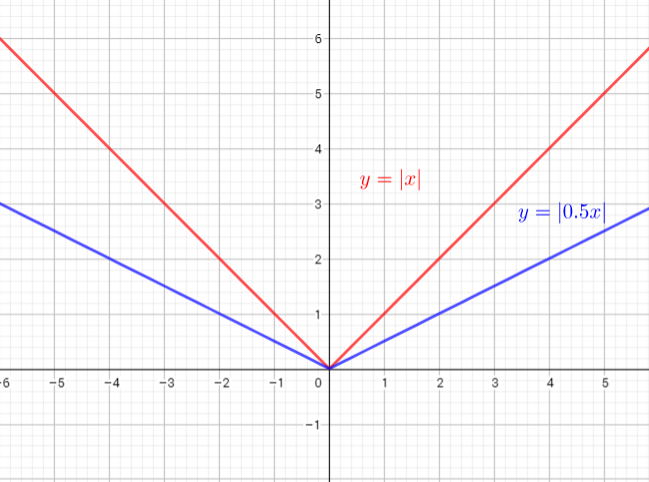
When $x$ is multiplied by a number between 0 and 1, the graph is stretched horizontally
To graph $y=(dfrac{1}{4}x)^{2}$ horizontal stretch the graph of $y=x^{2}$ horizontally by the factor $dfrac{1}{dfrac{1}{4}}=4$.
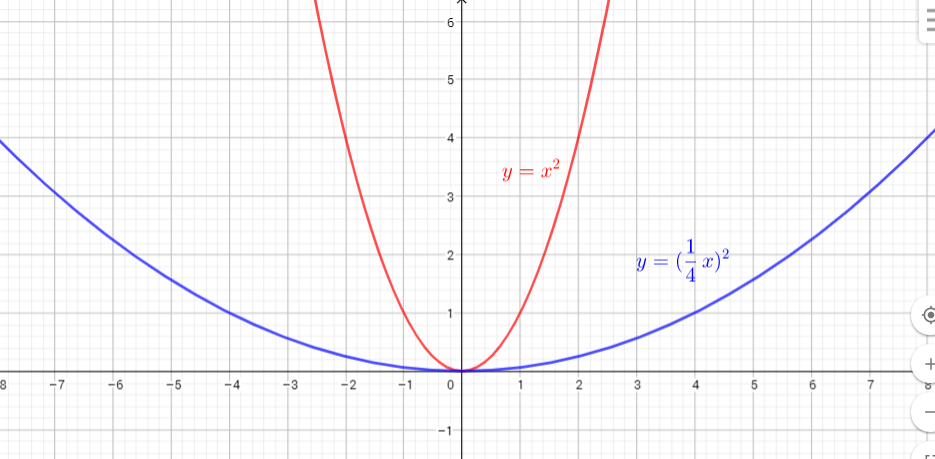
We know, when x is multiply by a number greater than 1, the graph
is compress horizontally, and if we switch the values of x and -x we reflect the graph of $y=x$ in the y-axis.
To graph $y=sqrt{-2x}$ horizontal stretch the graph of $y=sqrt{x}$ horizontally by the factor $dfrac{1}{2}$ and reflect the parent function
graph in the y-axis.
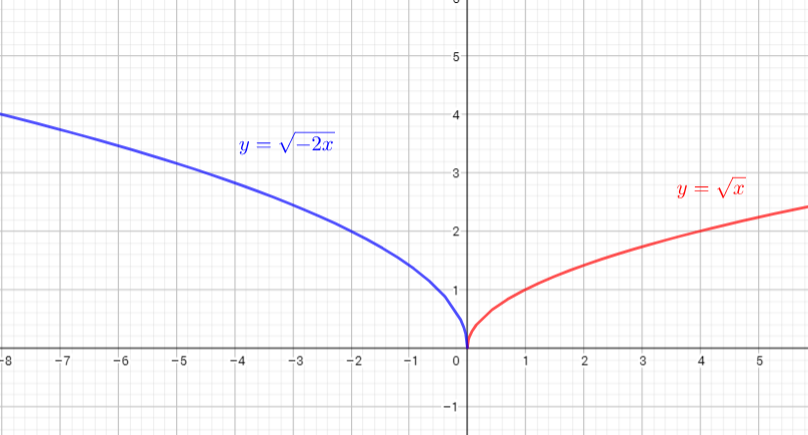
The graph $y=dfrac{1}{x}$ is compressed horizontally by the factor $dfrac{1}{5}$
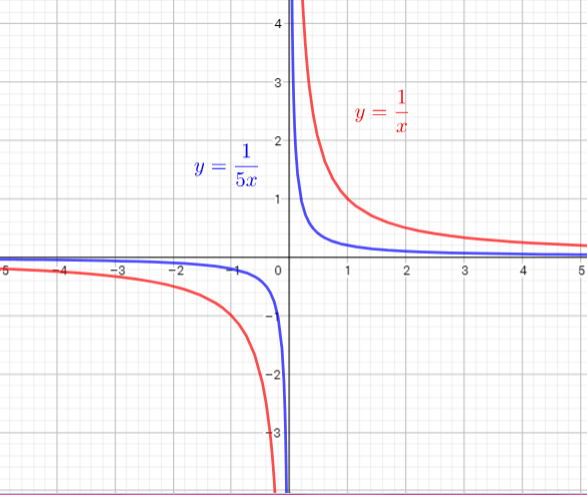
b) $y=x^2$ ; horizontal stretching by a factor of 4
c) $y=sqrt{x}$ ; horizontal compression by a factor of $dfrac{1}{2}$ and reflection in the $y$-axis
d) $y=dfrac{1}{x}$ ; horizontal compression by a factor of $dfrac{1}{5}$
To find the coordinates of the image of this point (3,4) on graph $y=f(2x)$ we need determine x- and y- coordintes on the new graph.
Since $y$ is equal we can equate
$4=f(3)=f(2 cdot x)$,
solve $3=2cdot x$ divide both sides by 2
$dfrac{3}{2}=x$ or $x=1.5$
So, the coordinates of the image of the point is (1.5, 4)
To find the coordinates of the image of this point (3,4) on graph $y=f(0.5x)$ we need determine x- and y- coordintes on the new graph.
Since $y$ is equal we can equate
$4=f(3)=f(0.5 cdot x)$,
solve $3=0.5cdot x$ divide both sides by 0.5
$dfrac{3}{0.5}=x$ or $x=6$
So, the coordinates of the image of the point is (6, 4)
To find the coordinates of the image of this point (3,4) on graph $y=f(dfrac{1}{3}x)$ we need determine x- and y- coordintes on the new graph.
Since $y$ is equal we can equate
$4=f(3)=f(dfrac{1}{3} cdot x)$,
solve $3=dfrac{1}{3}cdot x$ multiply both sides by 3
$3cdot3=x$ or $x=9$
So, the coordinates of the image is (9, 4)
To find the coordinates of the image of this point (3,4) on graph $y=f(-4x)$ we need determine x- and y- coordintes on the new graph.
Since $y$ is equal we can equate
$4=f(3)=f(-4cdot x)$,
solve $3=-4cdot x$ divide both sides by -4
$dfrac{3}{-4}=x$ or $x=-0.75$
So, the coordinates of the image is (-0.75, 4)
b) $(6,4)$
c) $(9,4)$
d) $(-0.75,4)$
if $k< 0$ the graph is also reflected in the y-axis.
The graph of $y=(2x)^{2}$ is the graph of the parent function $y=x^{2}$ is the graph is compressed horizontally by the factor $dfrac{1}{2}$. There is (0,0) invariant point.
The graph of $y=(5x)^{2}$ is the graph of the parent function $y=x^{2}$ is the graph is compressed horizontally by the factor $dfrac{1}{5}$. There is (0,0) invariant point.
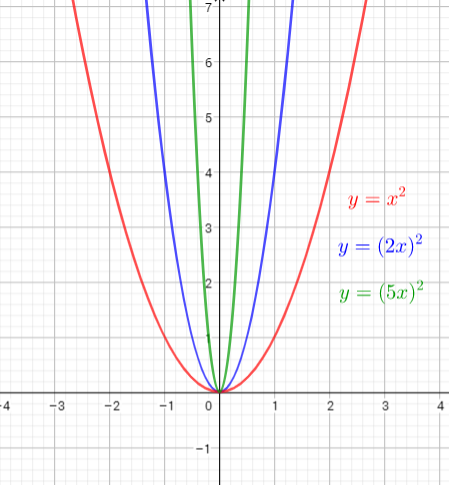
The parent function is $y=sqrt{x}$
The graph of $y=sqrt{3x}$ is the graph of the parent function $y=sqrt{x}$ is the graph is compressed horizontally by the factor $dfrac{1}{3}$. There is (0,0) invariant point.
The graph of $y=sqrt{4x}$ is the graph of the parent function $y=sqrt{x}$ isthe graph is compressed horizontally by the factor $dfrac{1}{4}$. There is (0,0) invariant point.
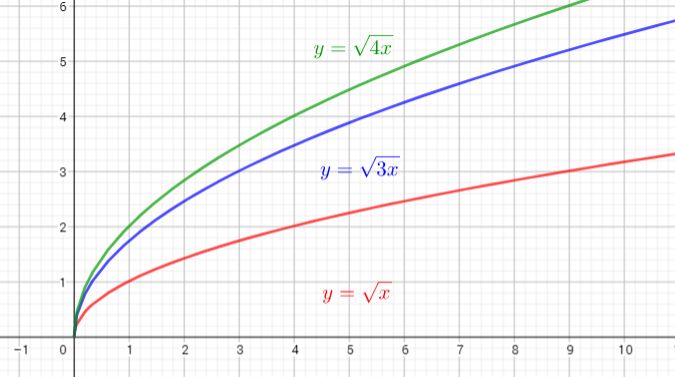
The parent function is $y=dfrac{1}{x}$
The graph of $y=dfrac{1}{2x}$ is the graph of the parent function $y=dfrac{1}{x}$ isthe graph is compressed horizontally by the factor $dfrac{1}{2}$. There is no invariant points.
The graph of $y=dfrac{1}{5x}$ is the graph of the parent function $y=dfrac{1}{x}$ isthe graph is compressed horizontally by the factor $dfrac{1}{5}$. There is no invariant points.
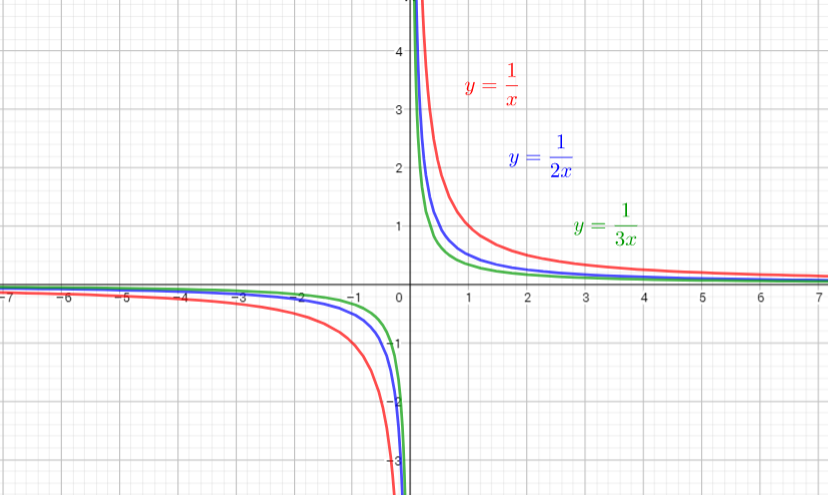
The graph of $y=|3x|$ is the graph of the parent function $y=|x|$ is the graph is compressed horizontally by the factor $dfrac{1}{3}$. There is (0,0) invariant point.
The graph of $y=|5x|$ is the graph of the parent function $y=|x|$ is the graph is compressed horizontally by the factor $dfrac{1}{5}$. There is (0,0) invariant point.
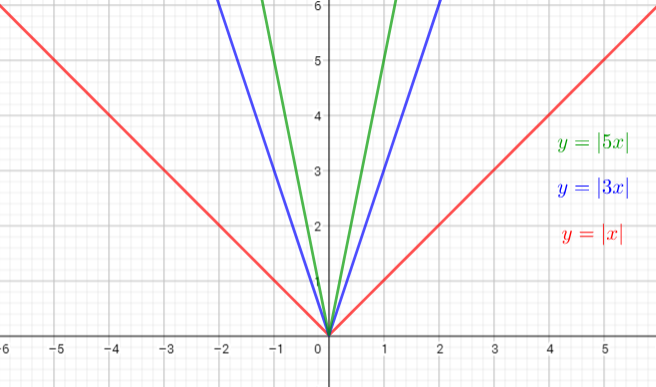
horizontal compression by a factor of $dfrac{1}{5}$, $(0,0)$
b) horizontal compression by a factor of $dfrac{1}{3}$ , $(0,0)$
horizontal compression by a factor of $dfrac{1}{4}$ , $(0,0)$
c) horizontal compression by a factor of $dfrac{1}{2}$, no invariant points
horizontal compression factor of $dfrac{1}{3}$, no invariant points
d) horizontal compression by a factor of $dfrac{1}{3}$, $(0,0)$
horizontal compression of $dfrac{1}{5}$ , $(0,0)$
1) if $0 < |k| 1$ then the graph $y=f(kx)$ is compressed horizontally by the factor $dfrac{1}{|k|}$ and
3) if $k< 0$ the graph is also reflected in the y-axis.
The graph of $y=(-2x)^{2}$ is the graph of the parent function $y=x^{2}$ . The graph is compressed horizontally by the factor $dfrac{1}{2}$ and reflected in the y-axis . There is (0,0) invariant point.
The graph of $y=(-5x)^{2}$ is the graph of the parent function $y=x^{2}$ . The graph is compressed horizontally by the factor $dfrac{1}{5}$ and reflected in the y-axis. There is (0,0) invariant point.
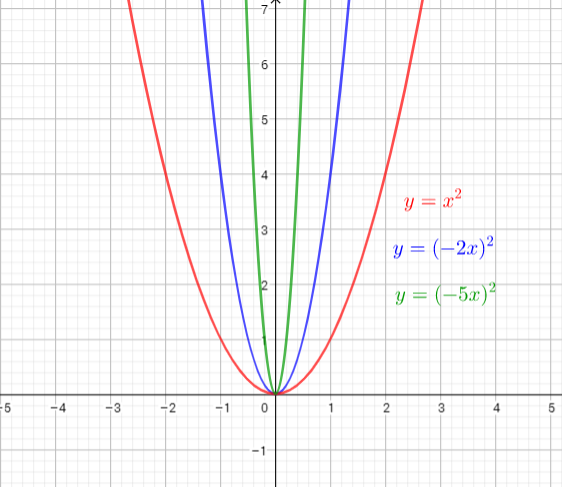
The parent function is $y=sqrt{x}$
The graph of $y=sqrt{-3x}$ is the graph of the parent function $y=sqrt{x}$ . The graph is compressed horizontally by the factor $dfrac{1}{3}$ and reflected in the y-axis. There is (0,0) invariant point.
The graph of $y=sqrt{-4x}$ is the graph of the parent function $y=sqrt{x}$ . The graph is compressed horizontally by the factor $dfrac{1}{4}$ and reflected in the y-axis. There is (0,0) invariant point.
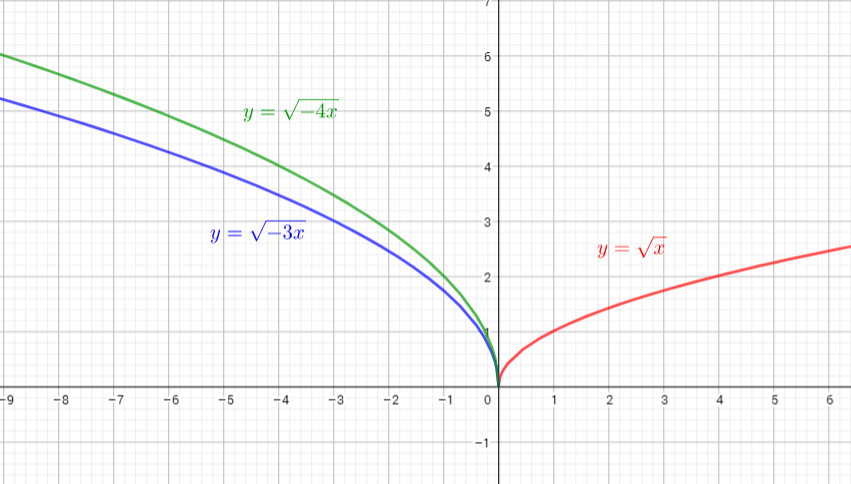
The parent function is $y=dfrac{1}{x}$
The graph of $y=dfrac{1}{-2x}$ is the graph of the parent function $y=dfrac{1}{x}$ . The graph is compressed horizontally by the factor $dfrac{1}{2}$ and reflected in the y-axis. There is no invariant points.
The graph of $y=dfrac{1}{-5x}$ is the graph of the parent function $y=dfrac{1}{x}$ .The graph is compressed horizontally by the factor $dfrac{1}{5}$ and reflected in the y-axis. There is no invariant point
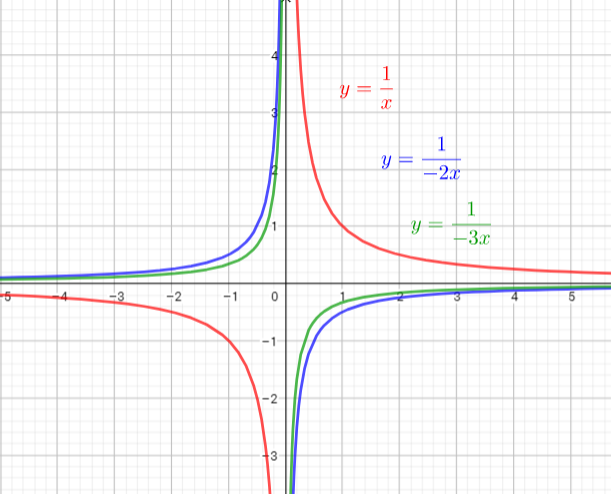
The graph of $y=|-3x|$ is the graph of the parent function $y=|x|$ . The graph is compressed horizontally by the factor $dfrac{1}{3}$ and reflected in the y-axis. There is (0,0) invariant point.
The graph of $y=|-5x|$ is the graph of the parent function $y=|x|$ . The graph iscompressed horizontally by the factor $dfrac{1}{5}$ and reflected in the y-axis. There is (0,0) invariant point.
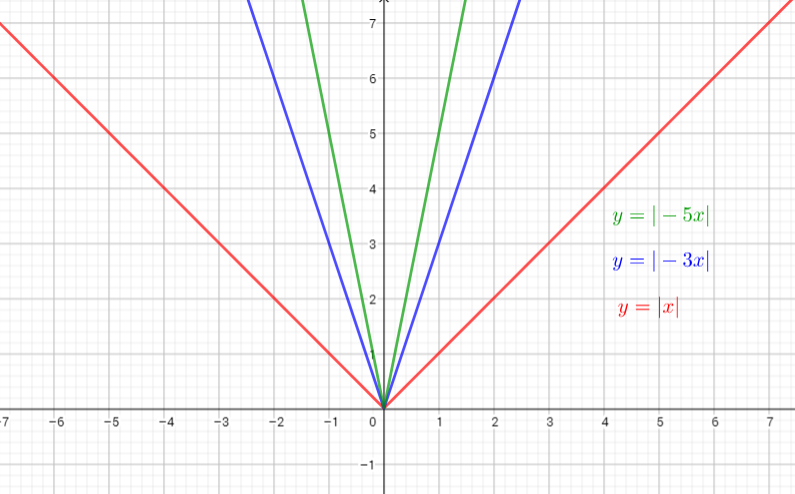
horizontal compression by a factor of $dfrac{1}{5}$ and reflection in $y$-axis, $(0,0)$
b) horizontal compression by a factor of $dfrac{1}{3}$ and reflection in $y$-axis , $(0,0)$
horizontal compression by a factor of $dfrac{1}{4}$ and reflection in $y$-axis , $(0,0)$
c) horizontal compression by a factor of $dfrac{1}{2}$ and reflection in $y$-axis, no invariant points
horizontal compression factor of $dfrac{1}{3}$ and reflection in $y$-axis, no invariant points
d) horizontal compression by a factor of $dfrac{1}{3}$ and reflection in the $y$-axis, $(0,0)$
horizontal compression by a factor of $dfrac{1}{5}$ and reflection in the $y$-axis , $(0,0)$
if $k< 0$ the graph is also reflected in the y-axis.
The graph of $y=(dfrac{1}{2}x)^{2}$ is the graph of the parent function $y=x^{2}$. The graph is stretched horizontally by the factor $2$. There is (0,0) invariant point.
The graph of $y=(dfrac{1}{3}x)^{2}$ is the graph of the parent function $y=x^{2}$ The graph is stretched horizontally by the factor $3$. There is (0,0) invariant point.
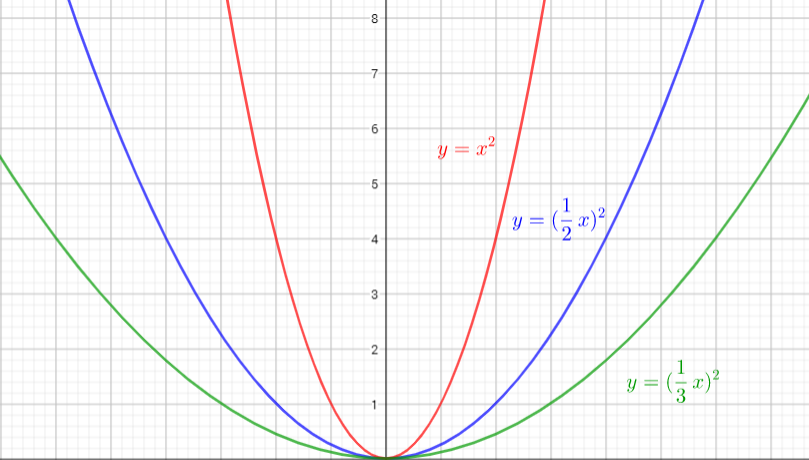
The parent function is $y=sqrt{x}$
The graph of $y=sqrt{dfrac{1}{2}x}$ is the graph of the parent function $y=sqrt{x}$ .The graph is stretched horizontally by the factor $2$. There is (0,0) invariant point.
The graph of $y=sqrt{dfrac{1}{3}x}$ is the graph of the parent function $y=sqrt{x}$. The graph isstretched horizontally by the factor $3$. There is (0,0) invariant point.
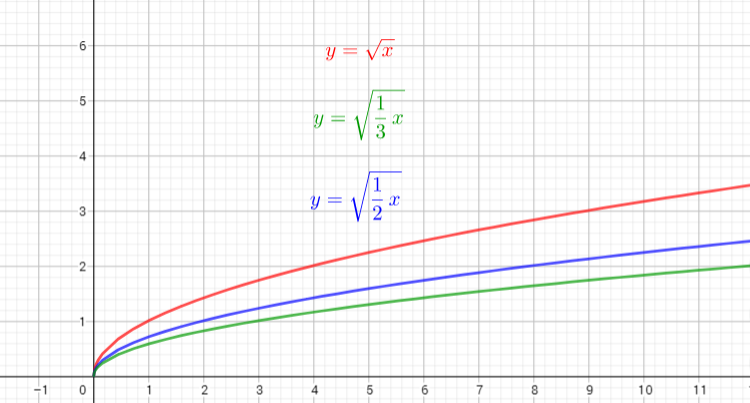
The parent function is $y=dfrac{1}{x}$
The graph of $y=dfrac{1}{(dfrac{1}{2}x)}$ is the graph of the parent function $y=dfrac{1}{x}$ .The graph is stretched horizontally by the factor $2$. There is no invariant points.
The graph of $y=dfrac{1}{(dfrac{1}{4}x)}$ is the graph of the parent function $y=dfrac{1}{x}$. The graph is stretched horizontally by the factor $4$. There is no invariant points.
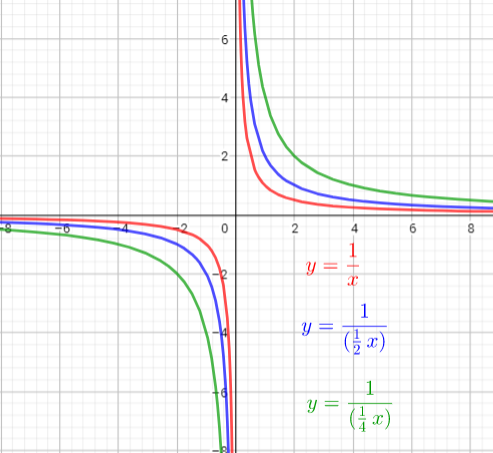
The graph of $y=|dfrac{1}{3}x|$ is the graph of the parent function $y=|x|$ . The graph is stretched horizontally by the factor $3$. There is (0,0) invariant point.
The graph of $y=|dfrac{1}{5}x|$ is the graph of the parent function $y=|x|$ is the graph stretched horizontally by the factor $5$. There is (0,0) invariant point.
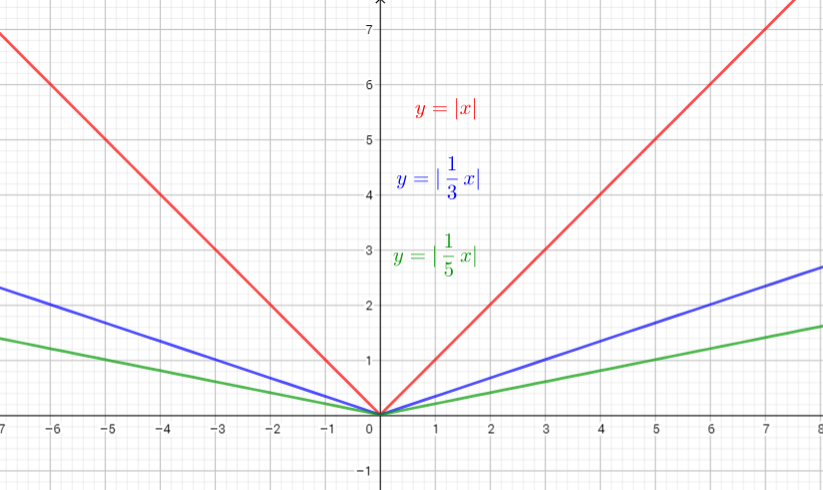
horizontal stretching by a factor of 3, $(0,0)$
b) horizontal stretching by a factor of 2 , $(0,0)$
horizontal stretching by a factor of 3, $(0,0)$
c) horizontal stretching by a factor of 2, no invariant points
horizontal stretching by a factor of 4, no invariant points
d) horizontal stretch by a factor of 3, $(0,0)$
horizontal stretch by a factor of 5 , $(0,0)$
if $k< 0$ the graph is also reflected in the y-axis.
The graph of $y=(-dfrac{1}{2}x)^{2}$ is the graph of the parent function $y=x^{2}$ . The graph is stretched horizontally by the factor $2$ and reflected in the y-axis. There is (0,0) invariant point.
The graph of $y=(-dfrac{1}{3}x)^{2}$ is the graph of the parent function $y=x^{2}$. The graph is stretched horizontally by the factor $3$ and reflected in the y-axis. There is (0,0) invariant point.
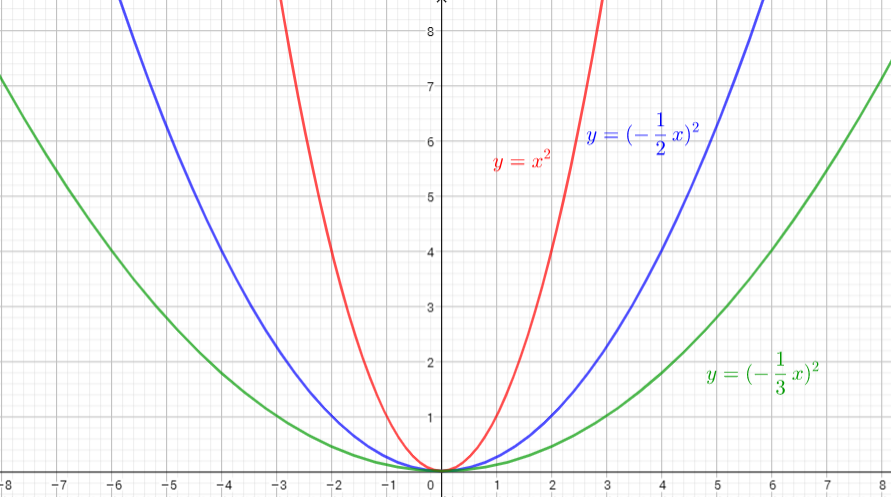
The parent function is $y=sqrt{x}$
The graph of $y=sqrt{-dfrac{1}{2}x}$ is the graph of the parent function $y=sqrt{x}$.The graph is stretched horizontally by the factor $2$ and reflected in the y-axis. There is (0,0) invariant point.
The graph of $y=sqrt{-dfrac{1}{3}x}$ is the graph of the parent function $y=sqrt{x}$ .The graph is stretched horizontally by the factor 3 and reflected in the y-axis. There is (0,0) invariant point.
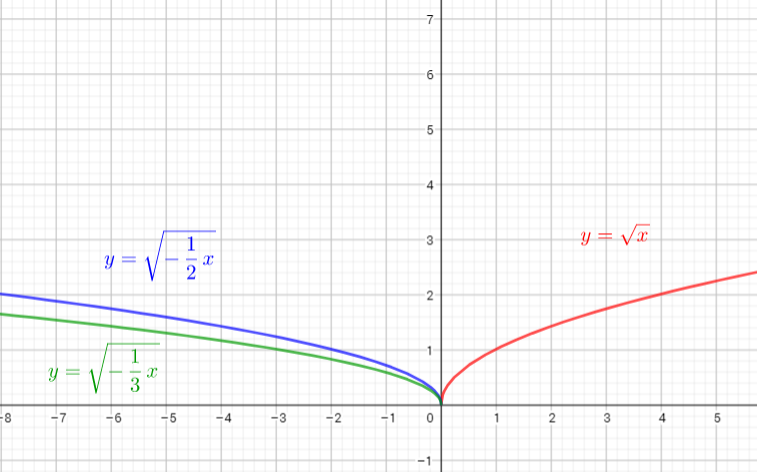
The parent function is $y=dfrac{1}{x}$
The graph of $y=dfrac{1}{(-dfrac{1}{2}x)}$ is the graph of the parent function $y=dfrac{1}{x}$ .The graph is stretched horizontally by the factor $2$ and reflected in the y-axis.. There is no invariant points.
The graph of $y=dfrac{1}{(-dfrac{1}{4}x)}$ is the graph of the parent function $y=dfrac{1}{x}$ The graph is stretched horizontally by the factor $4$ and reflected in the y-axis. There is no invariant points.
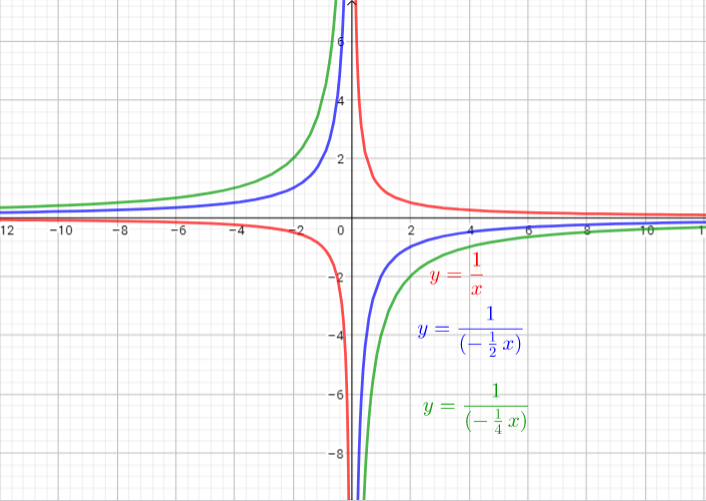
The graph of $y=|-dfrac{1}{3}x|$ is the graph of the parent function $y=|x|$ .The graph is stretched horizontally by the factor 3 and reflected in the y-axis. There is (0,0) invariant point.
The graph of $y=|-dfrac{1}{5}x|$ is the graph of the parent function $y=|x|$ is the graph stretched horizontally by the factor $5$ and reflected in the y-axis. There is (0,0) invariant point.
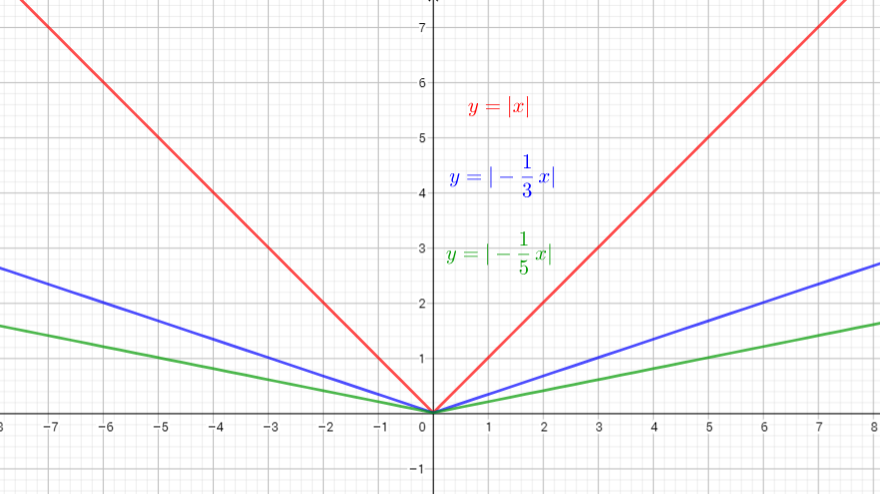
horizontal stretching by a factor of 3 and reflection in $y$-axis, $(0,0)$
b) horizontal stretching by a factor of 2 and reflection in $y$-axis , $(0,0)$
horizontal stretching by a factor of 3 and reflection in $y$-axis, $(0,0)$
c) horizontal stretching by a factor of 2 and reflection in $y$-axis, no invariant points
horizontal stretching by a factor of 4 and reflection in $y$-axis, no invariant points
d) horizontal stretching by a factor of 3 and reflection in $y$-axis, $(0,0)$
horizontal stretching by a factor of 5 and reflection in $y$-axis, $(0,0)$
The graph of $y=|2x|$ is the graph of the parent function $y=|x|$. The graph is compressed horizontally by the factor $dfrac{1}{2}$
The graph of $y=-dfrac{1}{2x}$ is the graph of the parent function $y=dfrac{1}{x}$. The graph is compressed horizontally by the factor 2 and reflected in the y-axis.
The graph of $y=(dfrac{1}{4}x)^{2}$ is the graph of the parent function $y=x^{2}$. The graph stretched horizontally by the factor $4$ and reflected in the y-axis
The graph of $y=sqrt{-3x}$ is the graph of the parent function $y=sqrt{x}$. The graph is compressed horizontally by the factor $dfrac{1}{3}$ and reflected in the y-axis.
b) $g(x)=-dfrac{1}{2x}$
c) $g(x)=left(dfrac{1}{4}right)^2$
d) $g(x)=sqrt{-3x}$
The domain is all the values that $h$ is allowed to take on. This function is defined for each $hgeq0$
We know, range is the set of all output values of a function.
In our case, for each $hgeq0$ we get $tgeq0$.
Domain=$left{ hin R| hgeq0right}$
Range=$left{tin R|tgeq0 right}$
We applied the horizontal stretch, multiplied the x-coordinates by
4.9 to find points on the
horizontally stretched graph: (1,1) moves to (4.9,1), (5.3) moves to (24.5, 3)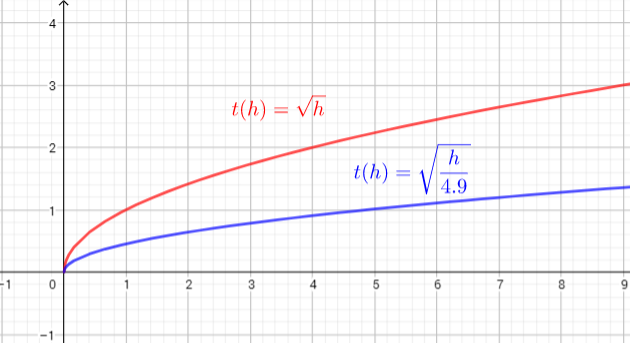
range = ${ tinbold{R};|;tgeq0}$
b) The graph has been plotted in the answers
If $f(x)$ is transformed to $f(kx)$, then it is $bold{horizontally ;scaled}$ by a factor of $dfrac{1}{|k|}$
If $f(x)$ contains the point $(a,b)$, then $f(kx)$ must contain $left(dfrac{a}{k},bright)$.
The graph can either be $bold{compressed}$ (if $|k|>1$) or $bold{stretched}$ (if $0<|k|<1$ )
If $k<0$, the graph is not just horizontally scaled but also reflected in the $y$-axis.
domain: ${ xinbold{R}}$
range : ${ yinbold{R};|;ygeq 0}$
$g(x)=dfrac{1}{4}x^2=left(dfrac{1}{2}xright)^2 implies$ horizontal compression by a factor of $dfrac{1}{1/2}=2$
domain: ${ xinbold{R}}$
range : ${ yinbold{R};|;ygeq 0}$
$h(x)=-4x^2=-(2x)^2 implies$ horizontal stretching by a factor of $dfrac{1}{2}$ and reflection in $x$-axis
domain: ${ xinbold{R}}$
range : ${ yinbold{R};|;yleq 0}$
The expression inside a square root must not be negative.
domain: ${ xinbold{R};|;xgeq 0}$
range: ${ yinbold{R};|;ygeq0}$
$g(x)=sqrt{dfrac{1}{5}x}implies$ horizontal compression by a factor of $dfrac{1}{1/5}=5$
domain: ${ xinbold{R};|;xgeq 0}$
range : ${ yinbold{R};|;ygeq0}$
$h(x)=sqrt{-5x}implies$ horizontal stretching by a factor of $dfrac{1}{5}$ and reflection in $y$-axis
domain: ${ xinbold{R};|;xleq 0}$
range : ${ yinbold{R};|;yleq0}$
domain = ${ xinbold{R};|;xneq 0}$
range = ${ yinbold{R};|;yneq 0}$
$g(x)=dfrac{1}{4x}implies$ vertical compression by a factor of $dfrac{1}{4}$
domain = ${ xinbold{R};|;xneq 0}$
range = ${ yinbold{R};|;yneq 0}$
$h(x)=dfrac{1}{left(-frac{1}{3}xright)}implies$ vertical stretching by a factor of $dfrac{1}{left|-1/3right|}=3$ and reflection in $y$-axis.
domain = ${ xinbold{R};|;xneq 0}$
range = ${ yinbold{R};|;yneq 0}$
domain = ${ xinbold{R}}$
range = ${ yinbold{R};|;ygeq0}$
$g(x)=|-2x|implies$ horizontal compression by a factor of $dfrac{1}{2}$ and reflection in $y$-axis
domain = ${ xinbold{R}}$
range = ${ yinbold{R};|;ygeq0}$
$h(x)=left|dfrac{1}{2}xright|implies$ horizontal stretching by a factor of $dfrac{1}{1/2}=2$
domain = ${ xinbold{R}}$
range = ${ yinbold{R};|;ygeq0}$
$h(x):$ domain = ${ xinbold{R}}$ , range = ${ yinbold{R};|;yleq0}$
b) $g(x)$: domain = ${ xinbold{R};|;xgeq 0}$ , range = ${ yinbold{R};|;ygeq0}$
$h(x)$: domain = ${ xinbold{R};|;xleq 0}$ , range = ${ yinbold{R};|;ygeq0}$
c) $g(x)$: domain = ${ xinbold{R};|;xneq 0}$ , range = ${ yinbold{R};|;yneq 0}$
$h(x)$: domain = ${ xinbold{R};|;xneq 0}$ , range = ${ yinbold{R};|;yneq 0}$
d) g(x): domain = ${ xinbold{R}}$ , range = ${ yinbold{R};|;ygeq0}$
h(x): domain = ${ xinbold{R}}$ , range = ${ yinbold{R};|;ygeq0}$
1) if $0 < |k| 1$ then the graph $y=f(kx)$ is compressed horizontally by the factor $dfrac{1}{|k|}$ and
3) if $k< 0$ the graph is also reflected in the y-axis.
b) The function $f(x)$ is compressed horizontally by the factor $dfrac{1}{2}$, so $dfrac{1}{k}=dfrac{1}{2}$, or $k=2$
c) The function $f(x)$ is reflected in the y-axis , so $k=-1$
d) The function $f(x)$ is compressed horizontally by the factor $dfrac{1}{5}$ so $dfrac{1}{k}=dfrac{1}{5}$, or $k=5$ and reflected in the y-axis so $k=-5.$
b) 2
c) $-1$
d) $-5$
The first, to find $f(2x)$, plug in $2x$ wherever $x$ occures in the equation of $f(x)$ and simplify to get $f(2x)$:
$f(2x)=(2x)^{2}-2x-6=4x^{2}-2x-6$.
Now, we need determine the x-intercepts for $f(2x)$.
We need solve quadratic equation $f(2x)=0$ or $4x^{2}-2x-6=0$ use the quadratic formula $x_{1,2}=dfrac{-b pm sqrt{b^{2}-4ac}}{2a}$ where $a, b$, and $c$ are the numerical coefficients of the terms of the quadratic equation
$a=4, b=-2$ and $c=-6$, substitute numerical coefficients in the quadratic formula we get:
$x_{1,2}=dfrac{-(-2) pm sqrt{(-2)^{2}-4cdot 4 cdot(-6)}}{2cdot4}$
$x_{1,2}=dfrac{2pmsqrt{4+96}}{8}=dfrac{2pmsqrt{100}}{8}$
$$
x_{1,2}=dfrac{2pm10}{8}
$$
$x_{1}=dfrac{2+10}{8}=dfrac{12}{8}=dfrac{3}{2}=1.5$ and
$x_{2}=dfrac{2-10}{8}=dfrac{-8}{8}=-1$
Solution is: x-intercepts for function $f(2x)$ are 1.5 and -1
The first, to find $f(dfrac{1}{3}x)$, plug in $dfrac{1}{3}x$ wherever $x$ occures in the equation of $f(x)$ and simplify to get $f(dfrac{1}{3}x)$:
$f(dfrac{1}{3}x)=(dfrac{1}{3}x)^{2}-dfrac{1}{3}x-6=dfrac{1}{9}x^{2}-dfrac{1}{3}x-6$.
Now, we need determine the x-intercepts for $f(dfrac{1}{3}x)$.
We need solve quadratic equation $f(dfrac{1}{3}x)=0$ or $dfrac{1}{9}x^{2}-dfrac{1}{3}x-6=0$, or ( multiply equation by 9) $x^{2}-3x-54=0$ use the quadratic formula $x_{1,2}=dfrac{-b pm sqrt{b^{2}-4ac}}{2a}$ where $a, b$, and $c$ are the numerical coefficients of the terms of the quadratic equation
$a=1, b=-3$ and $c=-54$, substitute numerical coefficients in the quadratic formula we get:
$x_{1,2}=dfrac{-(-3) pm sqrt{(-3)^{2}-4cdot 1 cdot(-54)}}{2cdot1}$
$x_{1,2}=dfrac{3pmsqrt{9+216}}{2}=dfrac{3pmsqrt{225}}{2}$
$$
x_{1,2}=dfrac{3pm15}{2}
$$
$x_{1}=dfrac{3+15}{2}=dfrac{18}{2}=9$ and
$x_{2}=dfrac{3-15}{2}=dfrac{-12}{2}=-6$
Solution is: x-intercepts for function $f(dfrac{1}{3}x)$ are 9 and -6
The first, to find $f(-3x)$, plug in $-3x$ wherever $x$ occures in the equation of $f(x)$ and simplify to get $f(-3x)$:
$f(-3x)=(-3x)^{2}-(-3x)-6=9x^{2}+3x-6$.
Now, we need determine the x-intercepts for $f(-3x)$.
We need solve quadratic equation $f(-3x)=0$ or $9x^{2}+3x-6=0$ use the quadratic formula $x_{1,2}=dfrac{-b pm sqrt{b^{2}-4ac}}{2a}$ where $a, b$, and $c$ are the numerical coefficients of the terms of the quadratic equation
$a=9, b=3$ and $c=-6$, substitute numerical coefficients in the quadratic formula we get:
$x_{1,2}=dfrac{-3 pm sqrt{3^{2}-4cdot 9 cdot(-6)}}{2cdot9}$
$x_{1,2}=dfrac{-3pmsqrt{9+216}}{8}=dfrac{-3pmsqrt{225}}{18}$
$$
x_{1,2}=dfrac{-3pm15}{18}
$$
$x_{1}=dfrac{-3+15}{18}=dfrac{12}{18}=dfrac{2}{3}$ and
$x_{2}=dfrac{-3-15}{18}=dfrac{-18}{18}=-1$
Solution is: x-intercepts for function $f(2x)$ are $dfrac{2}{3}$ and -1
b) $9,-6$
c) $-1,dfrac{2}{3}$
1) if $0 < k 1$ then the graph $y=f(kx)$ is compressed horizontally by the factor $dfrac{1}{k}$ and
3) if $k< 0$ the graph is also reflected in the y-axis.

1) if $0 < k 1$ then the graph $y=f(kx)$ is compressed horizontally by the factor $dfrac{1}{k}$ and and the graph of $kf(x)$ is stretched verticaly by the factor $k$
3) if $k< 0$ the graph is reflected in the y-axis and the graph of $kf(x)$ is reflected in the x-axis
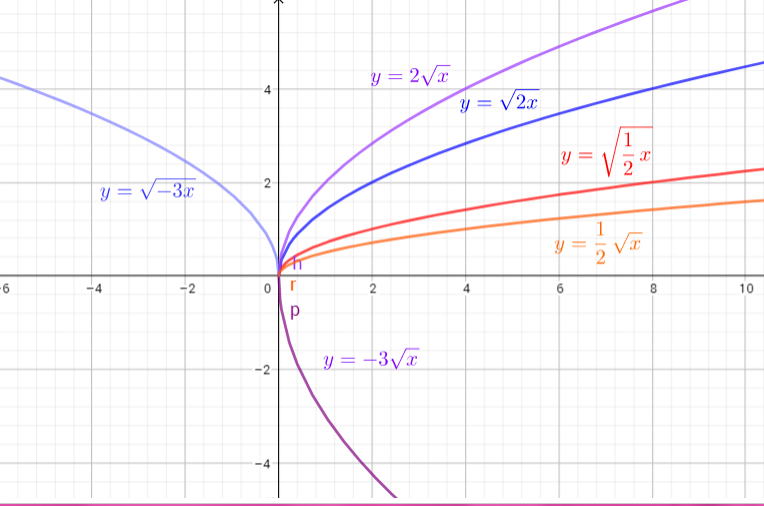
(1) if $0<|k|1$, the graph is horizontally compressed by $dfrac{1}{|k|}$
(3) if $k<0$, the graph is also reflected in the $y$-axis.
b) Horizontal stretching is equivalent to vertical compression and horizontal compression is equivalent to vertical stretching. However, the scale factors may or may not be reciprocal of each other.
b)-c) Graph of the function a horizontaly stretched with factor 2 and graph of the function a verticaly stretched with factor 2 are on the picture left (blue liine)
Use the graph, we can conclude that the horizontal and vertical stretches give the same graph.
d) We know that, if $0 < k<1$ then the graph $y=f(kx)$ is stretched horizontally by the factor $dfrac{1}{k}$, so, if factor equal 2, then $dfrac{1}{k}=2$ or $k=dfrac{1}{2}$. That means, a function is $y=f(dfrac{1}{2}x)=dfrac{1}{dfrac{1}{2}x}$
Graph $y=kf(x)$ is a vertical stretch with factor 2 if $k=2$. That means, a function is $y=2f(x)=2cdotdfrac{1}{x}$
Now we can simplify these functions:
$y=dfrac{1}{dfrac{1}{2}x}=dfrac{1}{dfrac{x}{2}}=dfrac{2}{x}$ and
$y=2cdotdfrac{1}{x}=dfrac{2}{x}$
If we compare $y=dfrac{1}{dfrac{1}{2}x}$ and $y=2cdotdfrac{1}{x}$
we can conclude the equations are the same and equal $y=dfrac{2}{x}$
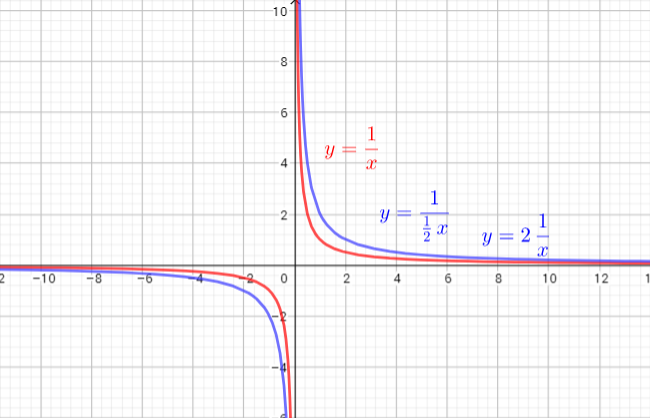
b) The horizontal and vertical stretches result in equivalent graph.
d) $y=dfrac{1}{frac{1}{2}x}$ , $y=2left(dfrac{1}{2}right)$ ; both are equal to $y=dfrac{2}{x}$
defarraystretch{1.5}%
begin{tabular}{|l|l|}
hline
Transformation & Description \ hline
$y=f(x)+c$ & begin{tabular}[c]{@{}l@{}}vertical translation of\ $c$ units upwardend{tabular} \ hline
$y=f(x+d)$ & begin{tabular}[c]{@{}l@{}}horizontal translation of $d$ units\ to the leftend{tabular} \ hline
$y=acdot f(x)$ & begin{tabular}[c]{@{}l@{}}vertical stretching by a factor of $a$end{tabular} \ hline
$y=f(kx)$ & begin{tabular}[c]{@{}l@{}}horizontal compression by $dfrac{1}{|k|}$end{tabular} \ hline
$y=-f(x)$ & begin{tabular}[c]{@{}l@{}}reflecting the function in\ the $x$-axisend{tabular} \ hline
$y=f(-x)$ & begin{tabular}[c]{@{}l@{}}reflecting the function in \ the $y$-axisend{tabular} \ hline
end{tabular}
end{table}
$y=f(2(x+2))$
The transformations are:
(1) horizontal compression by a factor of $dfrac{1}{2}implies y=f(2x)$
(2) horizontal translation 2 units to the left $implies y=f(2(x+2))$
(1) horizontal translation 2 units to the left $implies y=f(x+2)$
(2) horizontal compression by a factor of $dfrac{1}{2}implies y=f(2x+2)$
Thus, the order does matter here.
The graph is different when the order is reversed.
(2) horizontal translation 2 units to the left
The order does matter.

